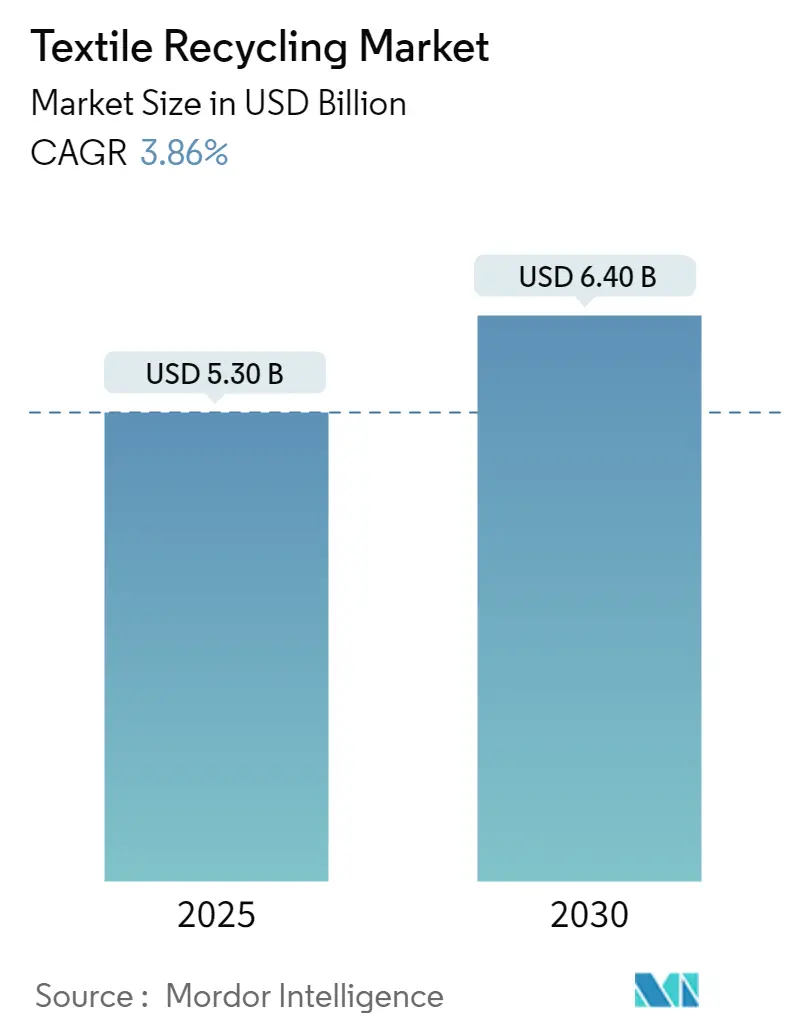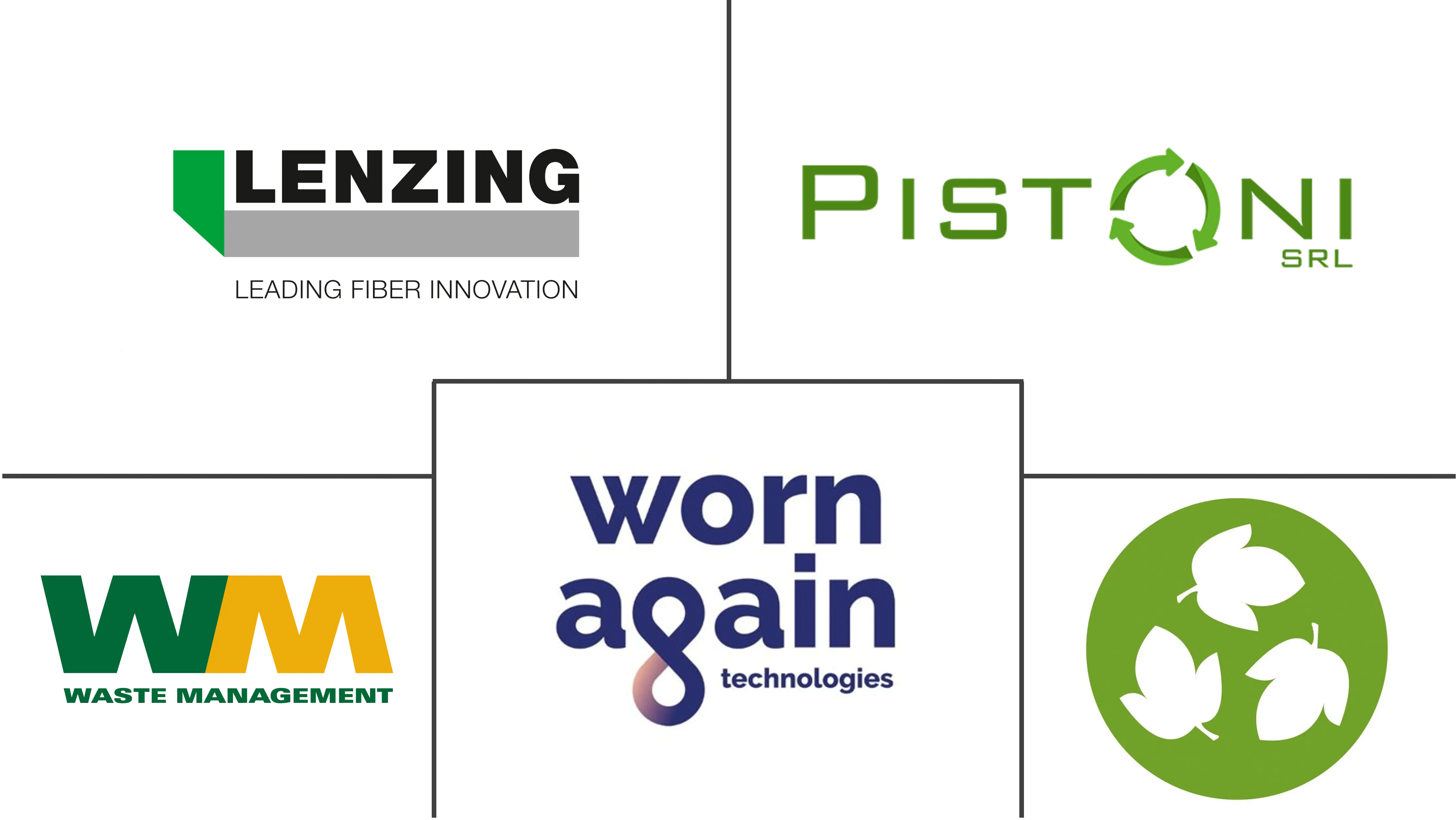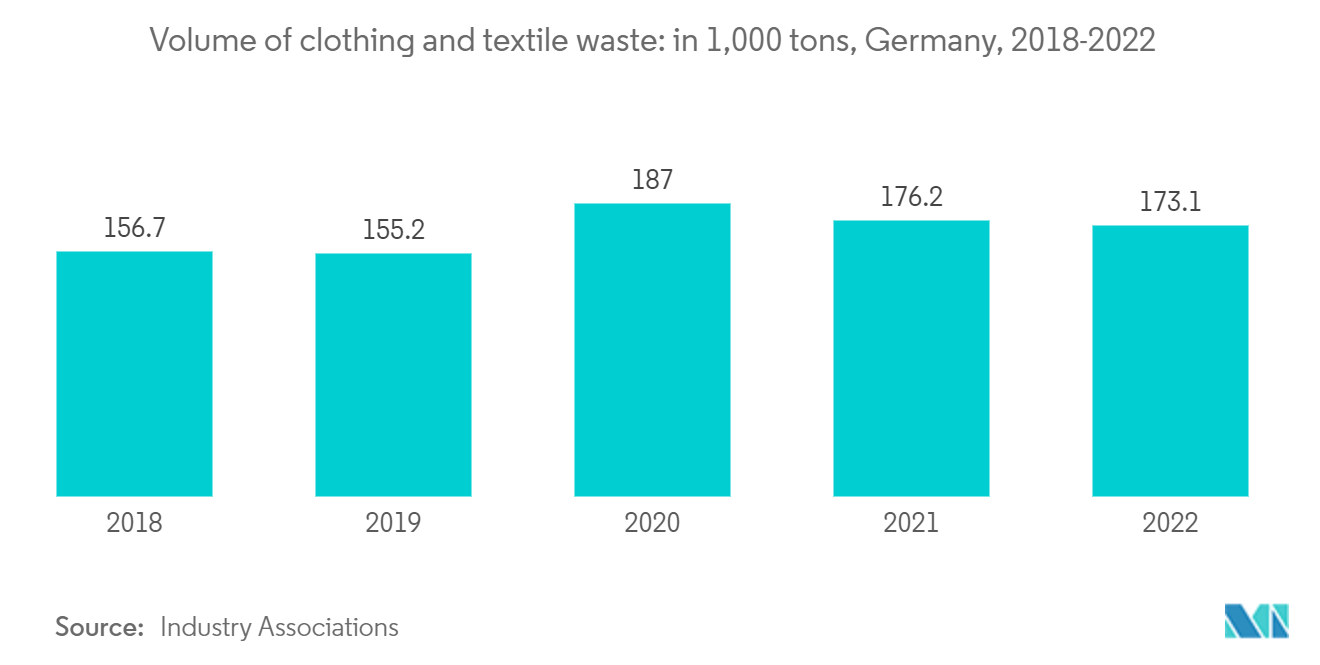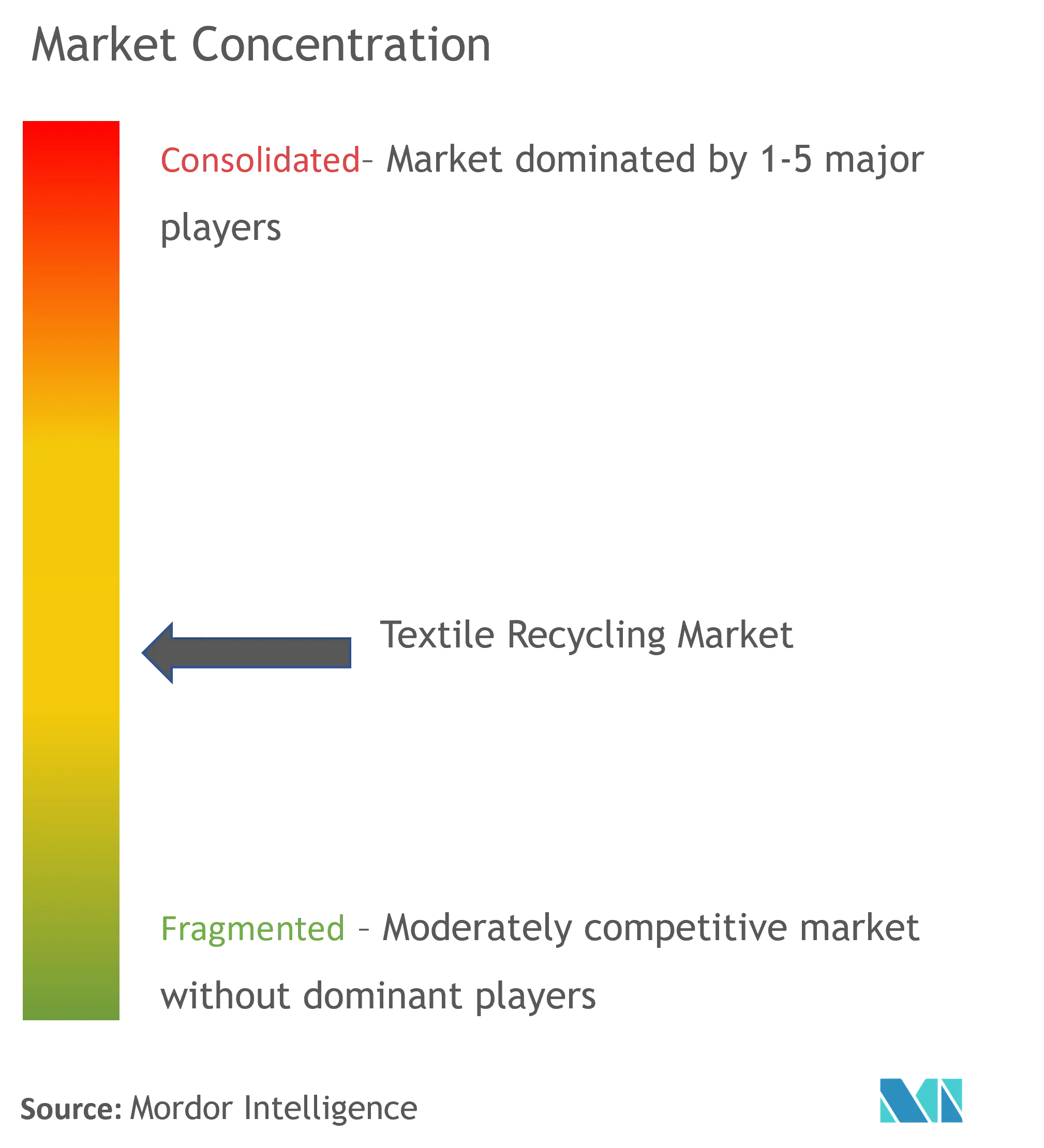
| Study Period | 2020 - 2030 |
| Base Year For Estimation | 2024 |
| Forecast Data Period | 2025 - 2030 |
| Market Size (2025) | USD 5.30 Billion |
| Market Size (2030) | USD 6.40 Billion |
| CAGR (2025 - 2030) | 3.86 % |
| Market Concentration | Medium |
Major Players
*Disclaimer: Major Players sorted in no particular order |
Textile Recycling Market Analysis
The Textile Recycling Market size is estimated at USD 5.30 billion in 2025, and is expected to reach USD 6.40 billion by 2030, at a CAGR of 3.86% during the forecast period (2025-2030).
According to industry reports, textiles are the fourth highest source of environmental and climatic change pressure in terms of European consumption. The management of used textiles, as well as textile waste, is a major challenge for Europe. Due to the limited capacity for reuse and recycling in Europe, many used textiles collected within the EU are traded and exported to Africa and Asia, where their future is uncertain.
The US International Trade Commission (USITC) reported in October 2023 that the global apparel sector accounted for 1.8 % of global GHG emissions in 2021. The production of downstream materials (textile fibers and fabrics) accounted for about 90 % of the total sector’s carbon emissions. The industry is expected to significantly exceed its carbon emissions target for 2030, which is set in the 1.5°C pathway by the Paris Agreement.
Government policies are important in driving efforts and innovation in the textile waste management industry. They are a reflection of global and national obligations that drive operationalization and technological innovation in the area of textile waste management. For example, in March 2021, the UK government launched a comprehensive Waste Prevention Program to reduce the environmental and social impact of textile waste, as well as in other sectors focused on key areas such as recycling, regulation, compliance, sustainability, value addition, innovation, and entrepreneurship.
Textile Recycling Market Trends
Europe is Set to Revamp Initiatives Focused on Reducing Waste
In July 2023, the European Commission issued its strategies to revise the Waste Framework Directive, stressing new rules on the responsibility of textile producers and new targets for reducing food waste. According to the European Environmental Agency, the proposal could face difficulties effectively reducing overproduction and waste in the food and textiles sectors.
Europe faces a threat from climate change and the degradation of natural resources. To meet such challenges, the European Green Deal is set to change the EU into a resource-efficient and competitive economy, ensuring no net greenhouse gas emissions by 2050.
The European Commission says the European Green Deal has been its lifeline since the COVID-19 pandemic. One-third of the EUR 1.8 trillion (USD 1.93 trillion) investment in the Next Generation EU Recovery Plan and the EU's seven-year budget is financing the European Green Deal.

Technology is Revolutionizing the Textile Waste Management
Low-value waste can be transformed into new high-value textiles by recycling technologies. The need for innovation to exploit new recycling technologies enabling textile waste to be used as a basic material is underlined by political pressures and the climate crisis. To ensure any circular strategy's effectiveness, quality materials that can be recycled must be obtained.
Sulzer Ltd, together with Worn Again Technologies' unique solvent technology, provides equipment, technology, and expertise to form the heart of the process. New technologies and processes are also being adopted by textile recyclers to enhance efficiency and effectiveness. For example, Sulzer and H&M established Worn Again Technologies, which is working on a unique textile recycling process that turns textiles into virgin raw materials at their end of use.
A technology for the closed-loop recycling of textile waste was developed in March 2023 by Korea's Korean Research Institute on Chemical Technology. The KRICT research team has adopted an inexpensive and nontoxic biodegradable material to chemically discriminate polyester from a mixture of waste fabrics.
Textile Recycling Industry Overview
The competitive landscape in the textile recycling market consists of a mix of experienced enterprises, new companies, and organizations working on solutions that can be sustainably implemented. Separate divisions or subsidiaries dedicated to textile recycling are designated by well-established companies in the area of waste management, recycling, and textiles. Some fashion brands and retailers also integrate sustainability into their business models by including renewable textiles in their products. Public authorities and agencies affect the competitive landscape through regulation, incentives, and funding schemes to promote sustainable practices and textile recycling. Global leaders in the textile recycling market are Worn Again Technologies, Lenzing Group, and Birla Cellulose.
Textile Recycling Market Leaders
-
Worn Again Technologies
-
Lenzing Group
-
Birla Cellulose
-
Pistoni S.R.L
-
Waste Management Inc.
- *Disclaimer: Major Players sorted in no particular order

Textile Recycling Market News
- December 2023: The Accelerating Circularity Initiative was granted USD 1.5 million worth of funding from the Walmart Foundation, which will be used to scale up the new Building Circular Systems program. The funds will contribute to the development of the early stages of the program, which have so far shown the technical feasibility of textile-to-textile recycling systems.
- March 2023: Kelheim Fibres, a manufacturer of viscose, collaborated with Recycling Atelier Augsburg to produce quality products from recycled materials. The aim of this collaboration is to ensure that the fibers produced by Kelheim Fibres are manufactured from recycled wood, which it claims will further tighten the loop.
Textile Recycling Industry Segmentation
The textile recycling market includes processes and activities involved in the collection, sorting, processing, and reuse of textile and clothing products to extend the life of textile and clothing products and reduce their environmental impact. In the textile and fashion sectors, it aims to remove textiles from landfills, reduce waste, and promote a circular economy.
A complete background analysis of the textile recycling market, including the assessment of the economy and contribution of sectors in the economy, market overview, market size estimation for key segments, and emerging trends in the market segments, market dynamics, and geographical trends, and the impact of COVID-19 pandemic, is covered in the report.
The textile recycling market is segmented by material (cotton, polyester and polyester fiber, wool, nylon and nylon fiber, and others), source (apparel waste, home furnishing waste, automotive waste, and others), process (mechanical and chemical), and geography (North America, Europe, Asia-Pacific, Middle East and Africa, and South America). The report offers market size and forecasts for all the above segments in value (USD).
| By Material | Cotton | ||
| Polyester and Polyester Fiber | |||
| Wool | |||
| Nylon and Nylon Fiber | |||
| Others | |||
| By Source | Apparel Waste | ||
| Home Furnishing Waste | |||
| Automotive Waste | |||
| Others | |||
| By Process | Mechanical | ||
| Chemical | |||
| By Geography | North America | United States | |
| Canada | |||
| Europe | United Kingdom | ||
| Germany | |||
| France | |||
| Italy | |||
| Russia | |||
| Rest of Europe | |||
| Asia-Pacific | China | ||
| India | |||
| Indonesia | |||
| Bangladesh | |||
| Rest of Asia-Pacific | |||
| Middle East and Africa | |||
| South America | |||
Textile Recycling Market Research Faqs
How big is the Textile Recycling Market?
The Textile Recycling Market size is expected to reach USD 5.30 billion in 2025 and grow at a CAGR of 3.86% to reach USD 6.40 billion by 2030.
What is the current Textile Recycling Market size?
In 2025, the Textile Recycling Market size is expected to reach USD 5.30 billion.
Who are the key players in Textile Recycling Market?
Worn Again Technologies, Lenzing Group, Birla Cellulose, Pistoni S.R.L and Waste Management Inc. are the major companies operating in the Textile Recycling Market.
What years does this Textile Recycling Market cover, and what was the market size in 2024?
In 2024, the Textile Recycling Market size was estimated at USD 5.10 billion. The report covers the Textile Recycling Market historical market size for years: 2020, 2021, 2022, 2023 and 2024. The report also forecasts the Textile Recycling Market size for years: 2025, 2026, 2027, 2028, 2029 and 2030.
Our Best Selling Reports
Textile Recycling Industry Report
Statistics for the 2025 Textile Recycling market share, size and revenue growth rate, created by Mordor Intelligence™ Industry Reports. Textile Recycling analysis includes a market forecast outlook for 2025 to 2030 and historical overview. Get a sample of this industry analysis as a free report PDF download.





